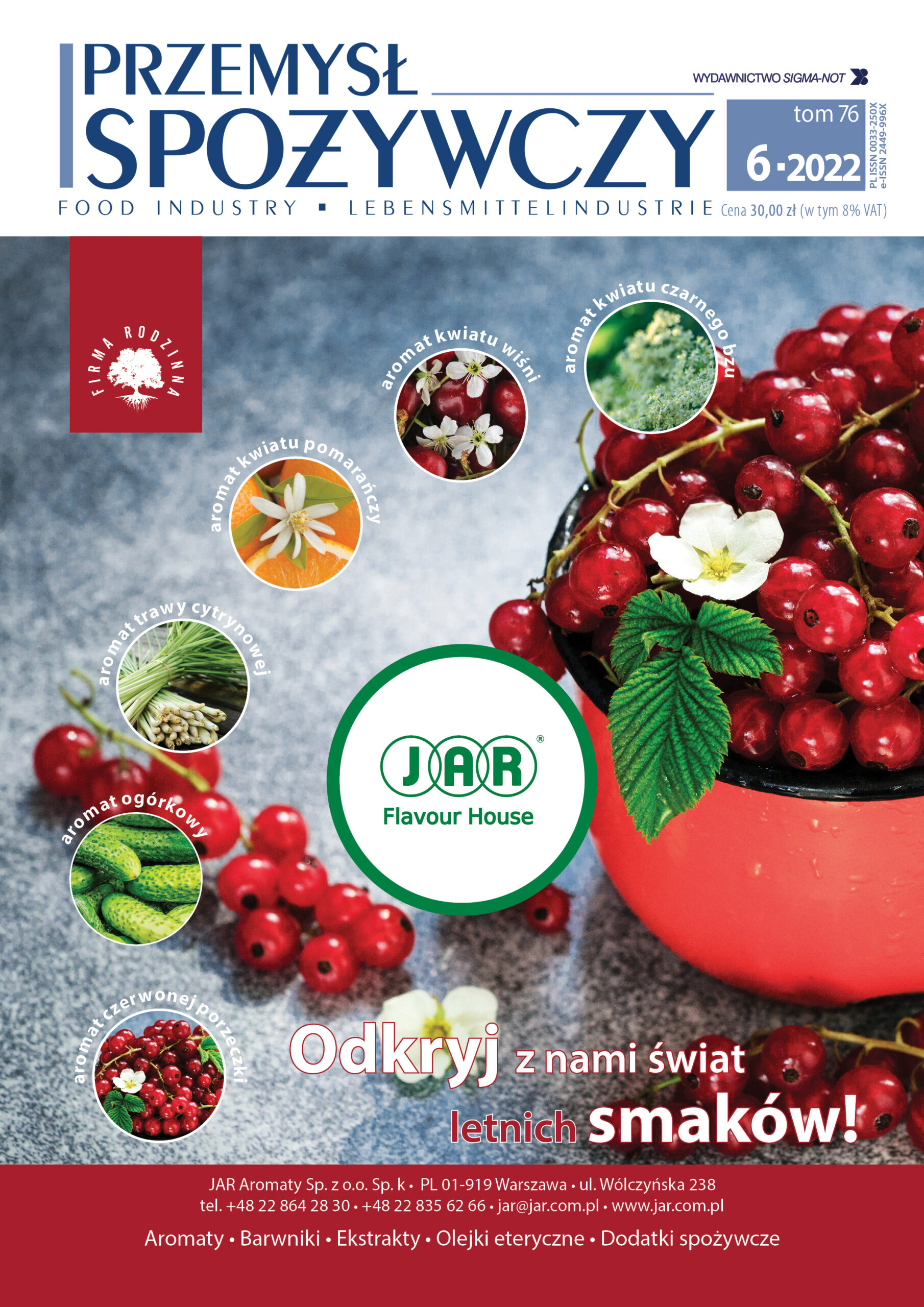ECONOMY
- Juice Sector in Poland (DOI10.15199/65.2022.6.1)
Iwona Szczepaniak, Bożena Nosecka 4
The article presents the level and changes in the production, consumption and export of juices, nectars as well as fruit and fruit and vegetable beverages in Poland in the years 2012-2021. The position of the Polish juice and beverages sector among other European Union countries was also assessed. The analysis shows that the production, export and consumption of drinking fruit juices, especially apple juice, increased dynamically in the past decade. As a result, Poland’s position as one of the EU’s biggest producers, exporters and consumers of juice has strengthened. However, the dynamics of production and consumption of vegetable juices, nectars as well as fruit and fruit and vegetable drinks was lower in Poland. In terms of the value of juice production, Poland came in high third place, and in terms of juice consumption per capita, fifth in the EU. The producers financial results , better than in previous year, provided companies with security of operation. However, their investment activity decreased.
KEY WORDA: juices, beverages, production, consumption, export, economic-financial situation, Poland, European Union
TECHNICS-TECHNOLOGY
- The Origin of Raw Water and The Formation of Biofilms in The Drinking Water Distribution Network (DOI10.15199/65.2022.6.2)
Dorota Kręgiel 10
The quality of drinking water is subject to very strict regulations and the water systems are regularly monitored, e.g. for microorganisms important to public health. Water systems are dominated by heterotrophic saprophytic bacteria called HPC (Heterotropic Plate Count), , but they should not be underestimated as they play an important role in the formation of biofilms. Apart from bacterial populations, fungi of the genera Penicillium, Phialophora, Cladosporium and Acremonium, yeasts, protozoa (e.g. Bodo), amoebas (e.g. Hartmannela vermiformis, Vannella mira, Cochliopodium minutum), ciliates and algae are also frequently present in water systems. All these microorganisms may participate in the formation of biofilms on surfaces in contact with water. Biofilms significantly affect the microbiological and organoleptic quality of drinking water as well as corrosive processes. The article discusses the causal relationships between biofilm formation and the origin of raw water, its biological composition and chemical characteristics.
KEY WORDA: raw water, chemistry, microorganisms, biofilms
- Sustainable Food – Quality „From Farm to Fork” (DOI10.15199/65.2022.6.3)
Ewa Sikorska, Urszula Samotyja, Anna Dankowska, Katarzyna Pawlak-Lemańska, Krzysztof Wójcicki, Jens Petter Wold 15
The sustainability of food systems is linked to the digital transformation of the food industry, which facilitates the transition from a linear to a circular economy. Based on the concept of Industry 4.0, control systems at all stages of the food chain and the use of artificial intelligence for data analysis should allow for the effective use of raw materials, optimization of processes, minimizing their negative impact on the environment, and providing high-quality products. High quality, considering the needs of consumers at the stage of designing and developing products, will ensure food with high nutritional and sensory values, and will contribute to the well-being of the society and reduce food waste. One of the challenges in transforming the food industry into Industry 4.0 is the development of food quality control methods and their implementation in the food chain ‘from farm to fork’. Work in this field requires the cooperation of scientists and practitioners from various fields and is a source of innovation.
KEY WORDA: smart sensors, food quality, industry 4.0, sustainable consumption, sustainable production
FOOD-FEEDING
- Facts And Myths About Juice (DOI10.15199/65.2022.6.4)
Barbara Groele 19
The quality of fruit and vegetable juices is strictly regulated by both European and country restrictive regulations. Juices may not contain preservatives, artificial colourings, flavours or sweeteners. In the case of fruit juices, it is also not allowed to added sugar. Only physical methods can be used during production and preservation. Juices contain many valuable micro- and macroelements necessary for the proper functioning of our body and to supporting the fight against civilization diseases. This is why juices can have such a positive effect on our health. According to expert recommendations, a glass of juice can be one of the five recommended servings of vegetables and fruits.
KEY WORDA: juice, health, vitamins, minerals
- The Analysis of The Selected Quality Discriminants Of Leaf Teas (DOI10.15199/65.2022.6.5)
Katarzyna Marciniak-Łukasiak, Michał Sowiński, Weronika Bieniek, Katarzyna Żbikowska, Anna Żbikowska 24
The aim of the study was to analyze selected discriminants of leaf teas. During the study, the infusions of black, and red tea, oolong, green and white tea were analyzed after 3 and 5 minutes of brewing. A sensory analysis of color, taste, aroma, and instrumental measurement of color was performed. Based on the obtained results, it was found that the infusion of 5-minute brewed teas are darker, as well as more tart, bitter, earthy, spicy and woody in taste and aroma than their shorter-brewed counterparts. There were also differences in color, taste and aroma between teas subjected to longer oxidation during the technological process.
KEY WORDA: teas, bioactive compounds of tea, sensory assessment, color
- Influence of the Variety of Raw Material on Selected Quality Characteristics of Haskap Berry Juices (DOI10.15199/65.2022.6.6)
Stanisław Kalisz, Natalia Polak, Małgorzata Jodłowska 32
The aim of the research was to determine the influence of the blue honeysuckle variety on selected quality characteristics of juices. Juices were obtained from the fruit of the Kamchatka berry of the Czelabinka, Dlinnopłodna, Klon 44, Sinogłaska and Wojtek varieties. The extract content, titratable acidity, total polyphenols and anthocyanins content were determined in the obtained juices. Moreover, the juices were subjected to an organoleptic evaluation. On the basis of the analysis of the results, it was found that the tested qualitative characteristics depend on the variety of fruit. The highest extract was found in fruit juices of the Sinogłaska variety (14.8%), and the highest acidity was 2.7% for the fruit juices of Sinogłaska, Czelabinka and Dlinnopłodna. Juices from fruits of the Dlinnopłodna variety were characterized by the highest content of total polyphenols (416.0 mg/100 mL) and anthocyanins (365.2 mg/100 mL). It has been shown that sour juices contain more polyphenols and anthocyanins and are better assessed in terms of the colour. In terms of taste and aroma, the juices from the Polish variety Klon 44 were rated the highest.
KEY WORDA: blue honeysuckle, cultivar, juice, polyphenols, anthocyanins
- Black Cumin, Baikal Skullcap, Buckwheat Hull – Potential Sources of Natural Antioxidants (DOI10.15199/65.2022.6.7)
Adam Zwolan 37
Food purchasing decisions are largely determined by consumers’ nutritional knowledge. Growing consumer awareness and controversy over the use of synthetic additives challenge the food industry to ensure high quality product using natural additives. In order to reduce the negative chemical changes caused by oxidation, compounds of plant origin, such as polyphenols, are increasingly added to food products. Besides fruit and vegetables, a rich source of polyphenols, and thus compounds with antioxidant properties are spices and herbs. Research is constantly being conducted to find new potential sources of natural antioxidants, the addition of which will not only protect food from adverse changes during storage, but also enrich it with bioactive components. Plants such as black cumin, baikal skullcap or buckwheat can be used for this purpose.
KEY WORDA: lipid oxidation, antioxidants, black cumin, baikal skullcap, buckwheat
LOGISTIC-PACKAGING
- Food Packaging – Current State and Prospects (DOI10.15199/65.2022.6.8)
Marta Lenartowicz-Klik 40
Although there are only a few months left of 2022, this year and 2021 has brought about some interesting trends within the packaging industry. With e-commerce continuing to be a consumer preference, technological advancement and sustainability continue to be a priority, the packaging industry has implemented and adapted to various industry trends worldwide. From the functional role of the packaging, through the marketing role, we have reached the place where responsibility and concern for the environment appeared. Especially since COVID-19 is still a common problem around the world, customers are looking for brands that can monitor and ensure that the product they buy and consume is hygienic and has not been opened up.
The article presents the perspectives of the packaging industry, innovative solutions used by the packaging industry and their current state.
KEY WORDA: packaging, recycling, ecology




